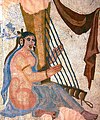
Angular harp
Angular harp is a category of musical instruments in the Hornbostel-Sachs system of musical instrument classification.[1] It describes a harp in which "the neck makes a sharp angle with the resonator," the two arms forming an "open" harp.[1][2] The harp stands in contrast to the arched harp or bow harp in which the angle is much less sharp and in which the neck curves away from the resonator (and can curve back above it in some harps). It also stands in contrast to the frame harp which is a "closed harp" and in which there is no opening between the resonator and the upper tip of the harp, but has a third side forming a triangle.[1]
The first angular harps appeared in Mesopotamia around 1900 B.C. and spread throughout the ancient East. They existed almost unchanged until the 17th century as the standard type of harp in Asia. Both vertical and horizontal versions are known; the vertical or horizontal describes the direction to which the strings are oriented. In vertical harps, the harp is traditionally plucked with the fingers. With horizontally held harps, the strings are played by plucking or with a plectrum or pick in ancient representations.







